A Quantitatively Operational Judging Method for the Process of Large Regional Heavy Haze Event Based on Satellite Remote Sensing and Numerical Simulations
Abstract
1. Introduction
2. Data and Methods
2.1. Data Sources
2.2. Methods
2.2.1. Coupled Method for Retrieval of Haze Aerosol Optical Depth based on Satellite Remote Sensing and Numerical Simulations
2.2.2. Quantitative Judging Method for the Process of Large Regional Heavy Haze Event
The Definition of Haze and Haze Severity Degree
The Definition of the Process of Large Regional Heavy Haze Event
3. Results and Discussion
3.1. HOD Results Validation
3.1.1. Validation from AERONET AOD Data
3.1.2. Validation from PM2.5 Mass Concentration Data of the Ground Observation Stations
3.2. Analysis of Regional Haze Process in Long-Time Series from November 2015 to 4 January 2015
3.3. Analysis of Typical Heavy Haze Process from 19 December 2015 to 24 December 2015
3.4. Analysis of Meteorological Conditions of Typical Heavy Haze Process
4. Conclusions
- (1)
- This study first established a coupled way to obtain HOD data by taking advantage of the two methods mainly based on remote sensing monitoring technologies in combination with numerical simulations. The validation for HOD retrieval results showed that the couple HOD from this study has good accuracy, the linear correlation coefficient between retrieval HOD and the AERONET Beijing station data and the PM2.5 data from the ground monitoring station were over 0.7 and 0.8 respectively.
- (2)
- On the basis of couple HOD method, this study first establishes a set of operationally quantitative judging methods for the process of larger regional heavy haze event, which includes the definition of haze and haze severity degree, judgment method for regional haze and heavy haze day, judgment method for the process of regional haze event, judgment method for the process of regional heavy haze event.
- (3)
- The applying results of the long time series haze event from December 2015 to 1 January 2016 shows that the methods put forward in this study are feasible to reflect the process of haze event, which can clearly reflect the regularity of generation, development and disappearance for the whole haze process.
- (4)
- The analysis of the typical heavy haze pollution processes that occurred in Beijing–Tianjin–Hebei and the surrounding regions from 17 December 2015 to 26 December 2015 shows that, compared with no obvious haze process during the same period of the last year, the regional heavy haze occurred in such steady meteorological conditions as large-area low air speed, high humidity and low boundary layer height, from which on the other hand can be verified that the methods for haze inversion and the haze process are reliable.
Acknowledgments
Author Contributions
Conflicts of Interest
References
- Ministry of Environmental Protection of the People’s Republic of China (MEP). Report on the State of the Environment in China in 2013. Available online: http://www.mep.gov.cn/hjzl/zghjzkgb/lnzghjzkgb/201605/P020160526564151497131.pdf (accessed on 5 October 2014). (In Chinese)
- Xu, P.; Chen, Y.F.; Ye, X. Haze, air pollution and health in China. Lancet 2013, 382, 2067. [Google Scholar] [CrossRef]
- Air Pollution Prevention and Control Action Plan. Available online: http://www.gov.cn/zwgk/2013-09/12/content_2486773.htm (accessed on 12 September 2013). (In Chinese)
- Ministry of Environmental Protection of the People’s Republic of China (MEP). Detailed Rules for the Implementation of the Action Plan for Preventing and Controlling Air Pollution in Beijing, Tianjin, Hebei and the Surrounding Areas. 2013; unpublished work. [Google Scholar]
- China Weather Network. Available online: http://www.tianqi.com/news/162366.html (accessed on 27 October 2016). (In Chinese).
- Weather China. Available online: http://www.weather.com.cn/static/html/article/20090310/26559.shtml (accessed on 10 March 2009). (In Chinese).
- World Meteorological Organization. Aerodrome Reports and Forecasts; World Meteorological Organization: Geneva, Switzerland, 2014; p. 78. [Google Scholar]
- Ministry of Environmental Protection. Ambient Air Quality Standard. Available online: http://kjs.mep.gov.cn/hjbhbz/bzwb/dqhjbh/dqhjzlbz/201203/t20120302_224165.htm (accessed on 10 October 2015). (In Chinese)
- Li, W.J.; Shao, L.Y.; Buseck, P.R. Haze types in Beijing and the influence of agricultural biomass burning. Atmos. Chem. Phys. 2010, 10, 8119–8130. [Google Scholar] [CrossRef]
- Li, Z.; Gu, X.; Wang, L.; Li, D.; Xie, Y.; Li, K.; Dubovik, O.; Schuster, G.; Goloub, P.; Zhang, Y.; et al. Aerosol physical and chemical properties retrieved from ground-based remote sensing measurements during heavy haze days in Beijing winter. Atmos. Chem. Phys. 2013, 13, 10171–10183. [Google Scholar] [CrossRef]
- Che, H.; Zhang, X.; Li, Y.; Zhou, Z.; Qu, J.; Hao, X. Haze trends over the capital cities of 31 provinces in China, 1981–2005. Theor. Appl. Climatol. 2009, 97, 235–242. [Google Scholar] [CrossRef]
- Noh, Y.M.; Muller, D.; Shin, D.H.; Lee, H.; Jung, J.S.; Lee, K.H.; Cribb, M.; Li, Z.; Kim, Y.J. Optical and microphysical properties of severe haze and smoke aerosol measured by integrated remote sensing techniques in Gwangju, Korea. Atmos. Environ. 2009, 43, 879–888. [Google Scholar] [CrossRef]
- Lee, K.H.; Kim, Y.J.; Kim, M.J. Characteristics of aerosol observed during two severe haze events over Korea in June and October 2004. Atmos. Environ. 2006, 40, 5146–5155. [Google Scholar] [CrossRef]
- Cheng, H.; Gong, W.; Wang, Z.; Zhang, F.; Wang, X.; Lv, X.; Liu, J.; Fu, X.; Zhang, G. Ionic composition of submicron particles (PM1.0) during the long-lasting haze period in January 2013 in Wuhan, central China. J. Environ. Sci. 2014, 26, 810–817. [Google Scholar] [CrossRef]
- China National Environmental Monitoring Center (CNEMC). Available online: http://106.37.208.233:20035/ (accessed on 12 December 2015).
- Chen, L.F.; Tao, J.H.; Wang, Z.F.; Li, S.S.; Han, D.; Zhang, Y. Monitoring of air quality during haze days in beijing and its surround area during Olympic Games. J. Atmos. Environ. Opt. 2009, 4, 256–265. [Google Scholar]
- Tao, M.; Chen, L.; Wang, Z.; Ma, P.; Tao, J.; Jia, S. A study of urban pollution and haze clouds over northern China during the dusty season based on satellite and surface observations. Atmos. Environ. 2014, 82, 183–192. [Google Scholar] [CrossRef]
- Gibbard, S.G.; Macintosh, B.; Gavel, D.; Max, C.E.; De Pater, I.; Roe, H.G.; Ghez, A.M.; Young, E.F.; McKay, C.P. Speckle imaging of Titan at 2 microns: Surface albedo, haze optical depth, and tropospheric clouds 1996–1998. Remote Sens. Environ. 2004, 169, 429–439. [Google Scholar] [CrossRef]
- Li, S.; Chen, L.; Xiong, X.; Tao, J.; Su, L.; Han, D.; Liu, Y. Retrieval of the Haze Optical Thickness in North China Plain Using MODIS Data. IEEE Trans. Geosci. Remote Sens. 2013, 51, 2528–2540. [Google Scholar] [CrossRef]
- Kaufman, Y.J.; Wald, A.; Remer, L.A. Remote sensing of aerosol over the continents with the aid of a 2.2 μm channel. IEEE Trans. Geosci. Remote Sens. 1997, 36, 1286–1298. [Google Scholar] [CrossRef]
- Levy, R.C.; Remer, L.A.; Mattoo, S.; Vermote, E.F.; Kaufman, Y.J. Second-generation operational algorithm: Retrieval of aerosol properties over land from inversion of Moderate Resolution Imaging Spectroradiometer spectral reflectance. J. Geophys. Res. Atmos. 2007, 112, D13211. [Google Scholar] [CrossRef]
- Hsu, C.N.; Tsay, S.C.; King, M.D.; Herman, J.R. Aerosol Properties over Bright-Reflecting. IEEE Trans. Geosci. Remote Sens. 2004, 42, 557–569. [Google Scholar] [CrossRef]
- Hsu, C.N.; Tsay, S.C.; King, M.D. Deep Blue Retrievals of Asian Aerosol Properties during ACE-Asia. IEEE Trans. Geosci. Remote Sens. 2006, 44, 3180–3195. [Google Scholar] [CrossRef]
- Huang, R.; Chen, H.; Ge, B.; Huang, S. Numerical study on source contributions to PM2.5 over Beijing-Tianjin-Hebei area during a severe haze event. Acta Scientiae Circumstantiae 2015, 35, 2670–2680. (In Chinese) [Google Scholar]
- Wu, Q.Z.; Wang, Z.F.; Gbaguidi, A.; Gao, C.; Li, L.N.; Wang, W. A numerical study of contributions to air pollution in Beijing during CAREBeijing-2006. Atmos. Chem. Phys. 2011, 11, 5997–6011. [Google Scholar] [CrossRef]
- Li, M.; Zhang, Q.; Kurokawa, J.; Woo, J.H.; He, K.B.; Lu, Z.; Ohara, T.; Song, Y.; Streets, D.G.; Carmichael. MIX: A mosaic Asian anthropogenic emission inventory for the MICS-Asia and the HTAP projects. Atmos. Chem. Phys. 2015, 15, 34813–34869. [Google Scholar] [CrossRef]
- Deng, W.; Chen, H.B.; Ma, Z.S. Decoding and Graphic Display of the NCEP FNL Global Analysis Data. Meteor. Environ. Sci. 2009, 32, 78–82. [Google Scholar]
- Vermote, E.F.; Tanre, D.; Deuzé, J.L.; Herman, M.; Morcrette, J.J. Second simulation of the satellite signal in the solar spectrum: An overview. IEEE Trans. Geosci. Remote Sens. 1997, 35, 675–686. [Google Scholar] [CrossRef]
- MODIS Level 1B Products Data Dictionary. Available online: https://mcst.gsfc.nasa.gov/sites/mcst.gsfc/files/file_attachments/M1055.pdf (accessed on 9 November 2016).
- Guenther, B.; Godden, G.D.; Xiong, X.; Knight, E.J.; Qiu, S.; Montgomery, H.; Hopkins, M.M.; Khayat, M.G.; Hao, Z. Prelaunch Algorithm and Data Format for the Level 1B Calibration Products for the EOS AM-1 Moderate Resolution Imaging Spectroradiometer (MODIS). IEEE Trans. Geosci. Remote Sens. 1998, 36, 1142–1151. [Google Scholar] [CrossRef]
- Wang, Z.; Wang, Z.; Li, J.; Zheng, H.; Yan, P.; Li, J. Development of a meteorology-chemistry two-way coupled numerical model (WRF-NAQPMS) and its application in a severe autumn haze simulation over the Beijing-Tianjin-Hebei area, China. Clim. Environ. Res. 2014, 19, 153–163. (In Chinese) [Google Scholar]
- PRC Meteorological Industry Standard. Observation and Forecasting Levels of Haze; China Meteorological Administration, China Meteorological Press: Beijing, China, 2010.
- Seng, L.F.; Shen, L.L.; Li, X.Z.; Liu, F. Studies on the Application of Empirical Formulae to the Calculation of Horizontal Visibility in Qingdao Coastal Area. Periodical Ocean Univ. Chin. 2009, 39, 877–882. [Google Scholar]
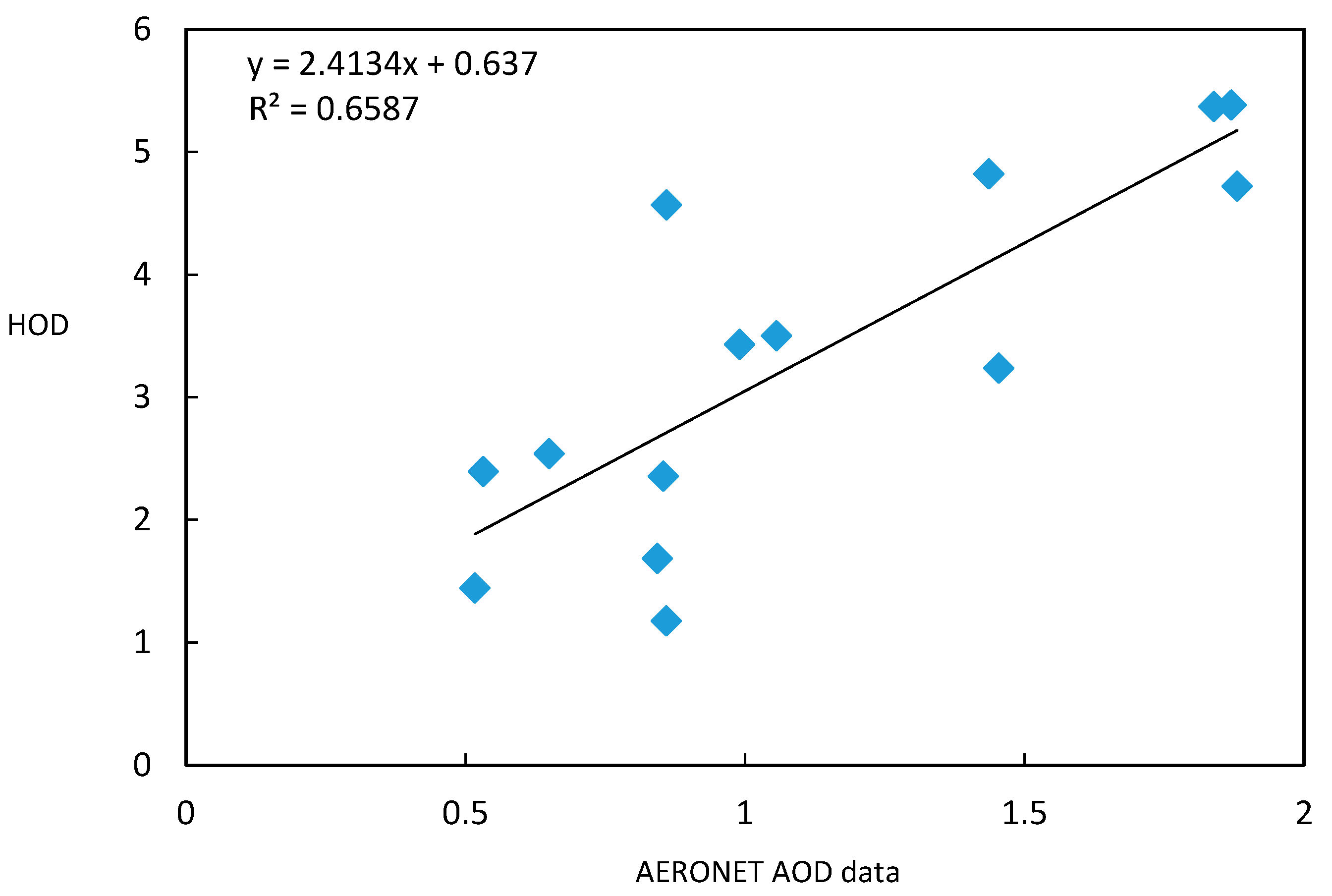
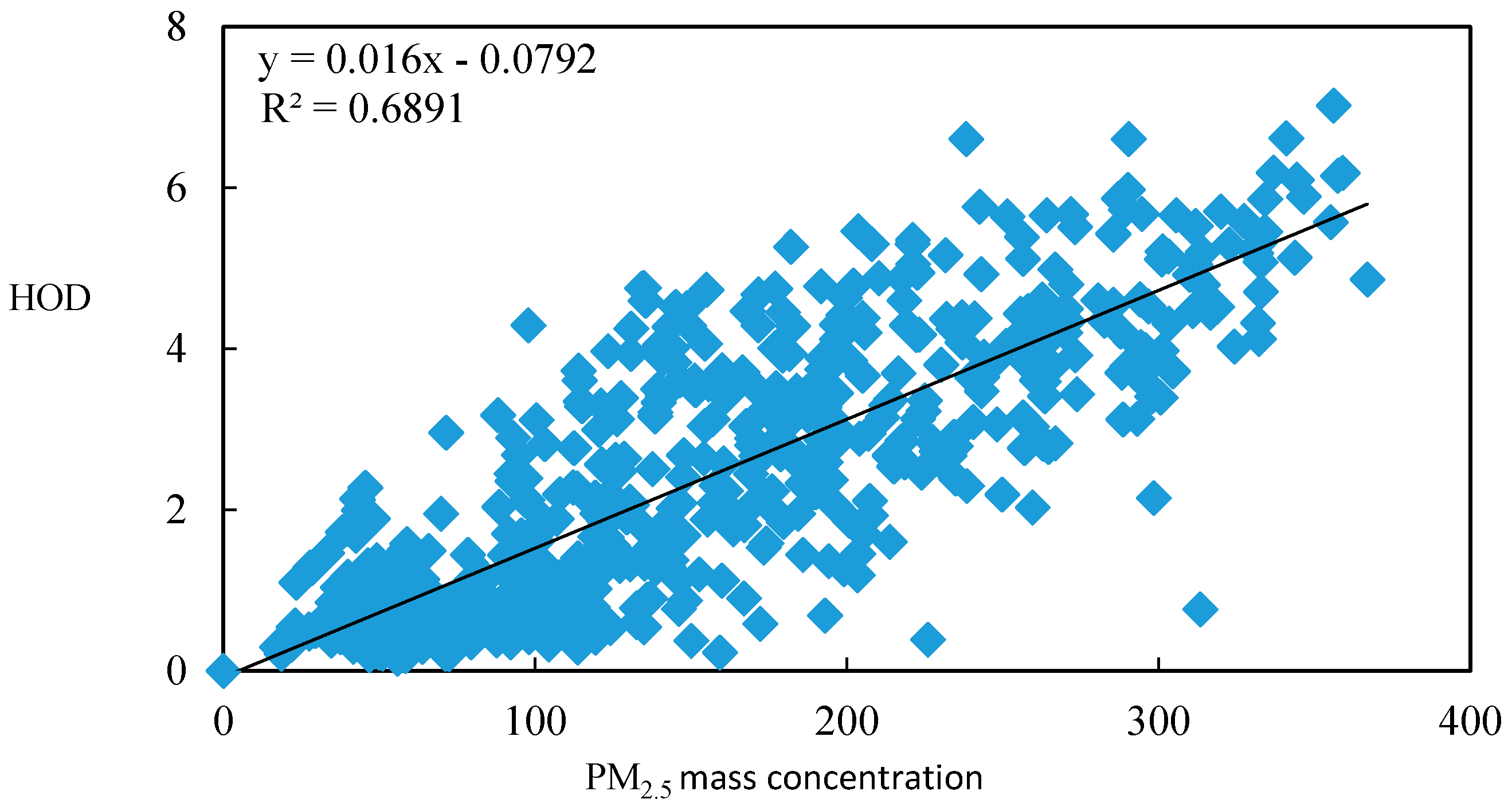
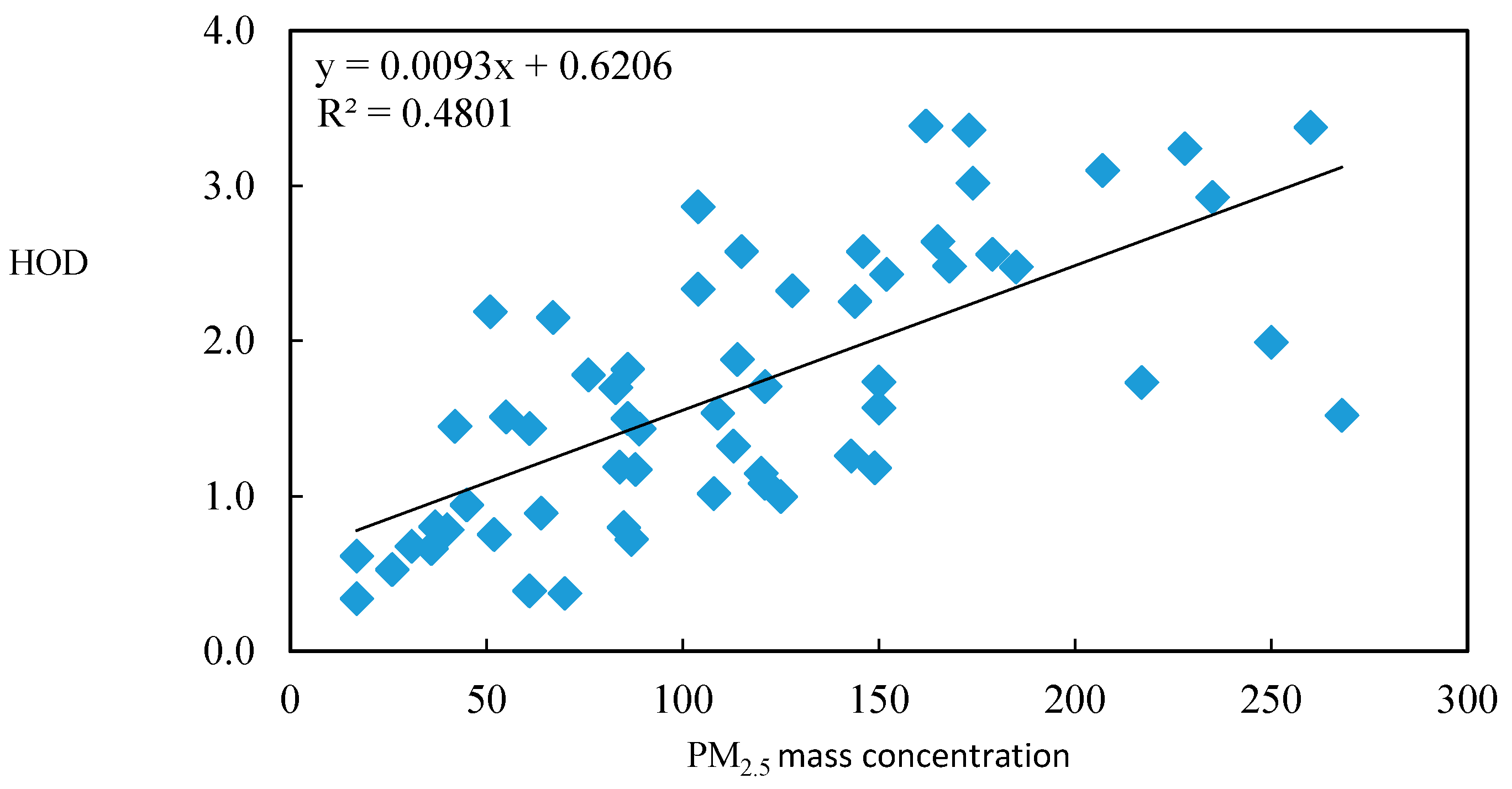

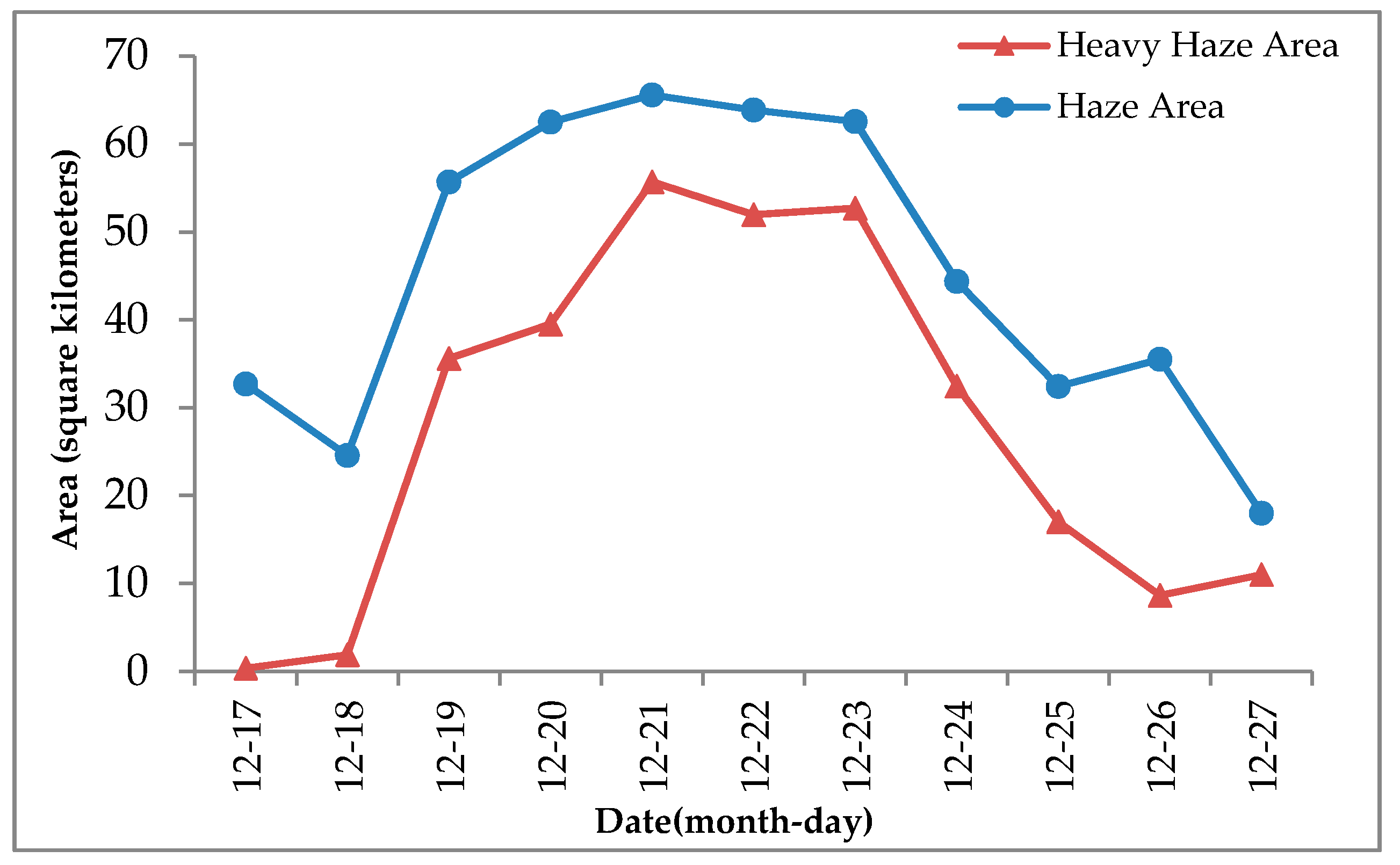
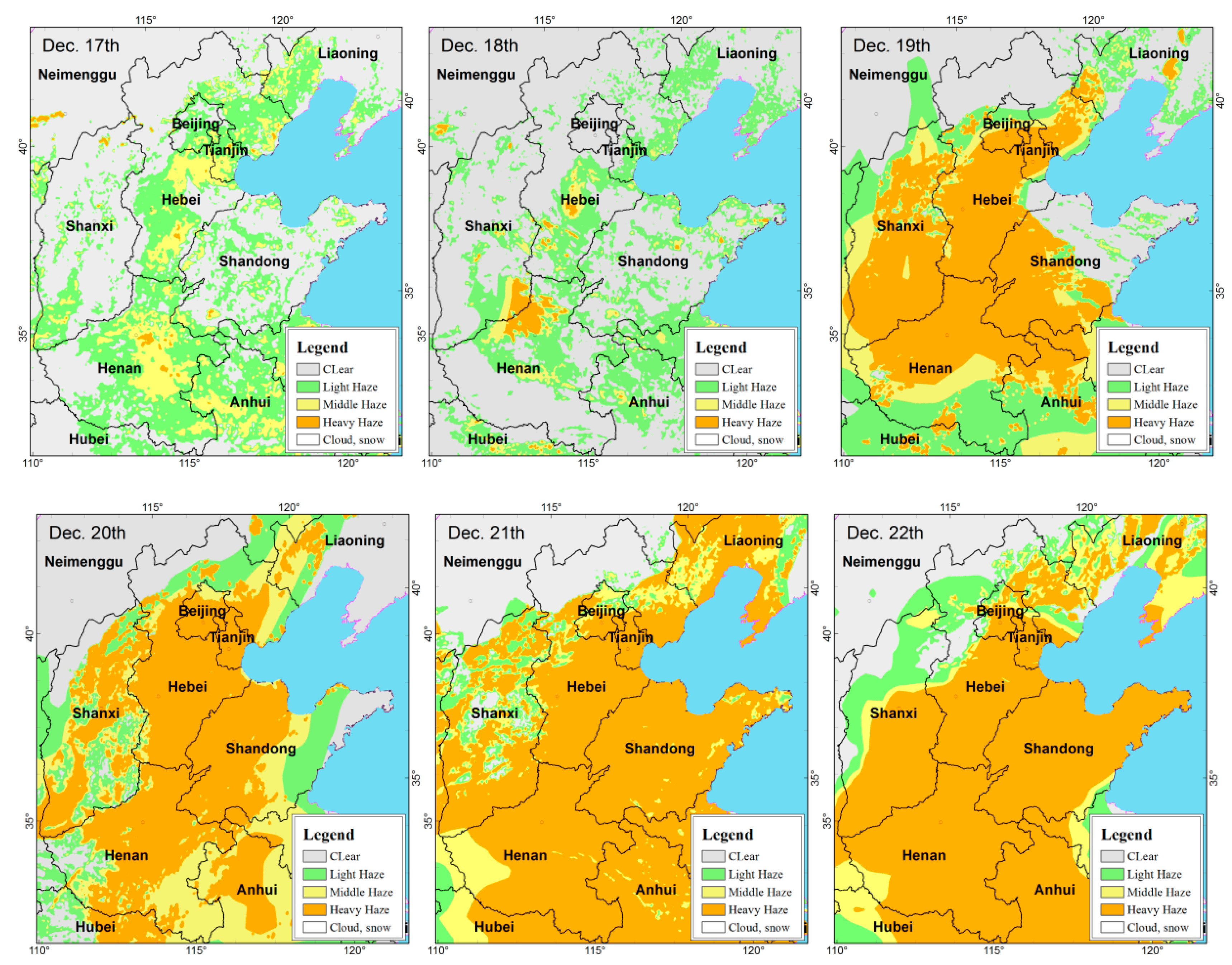
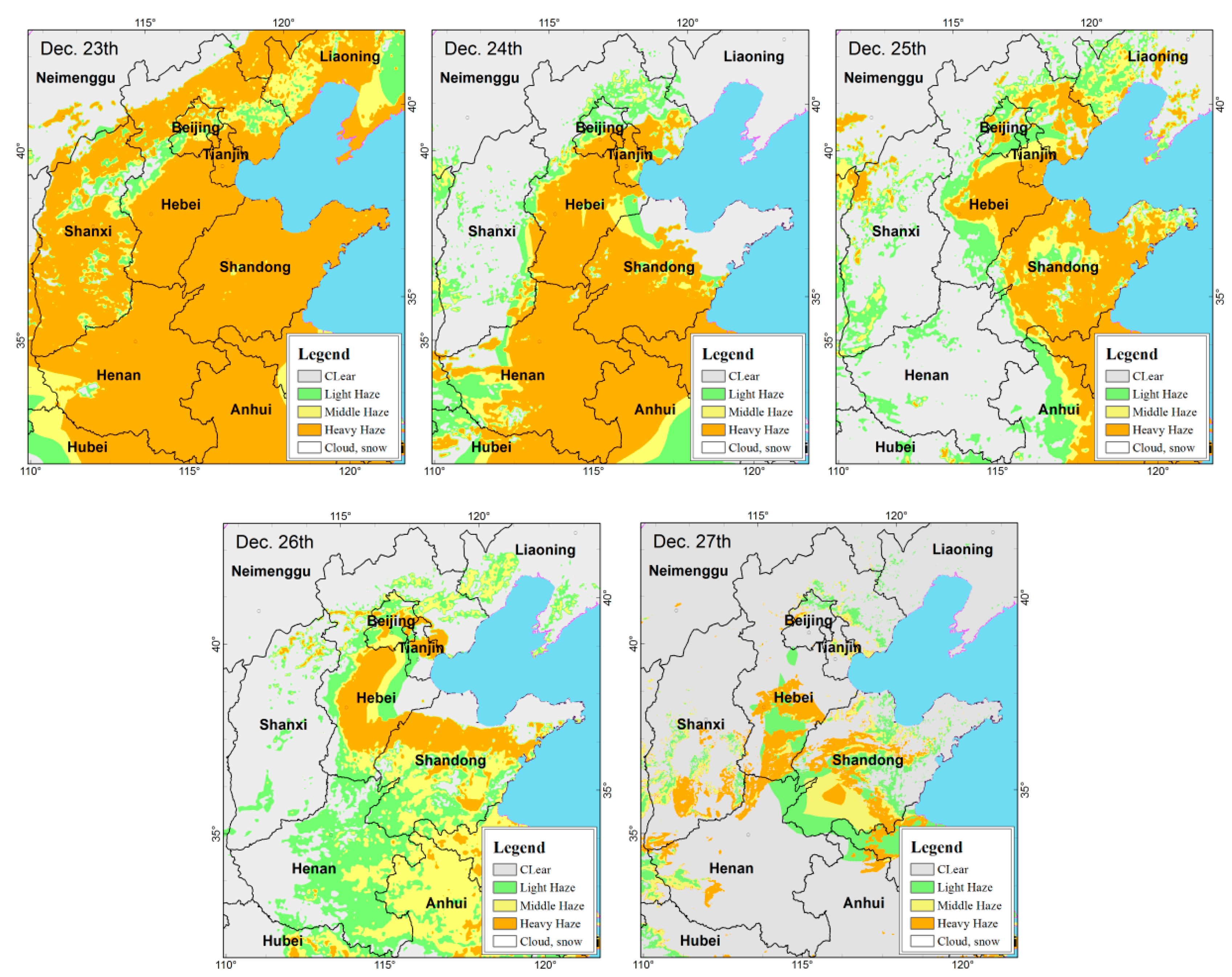
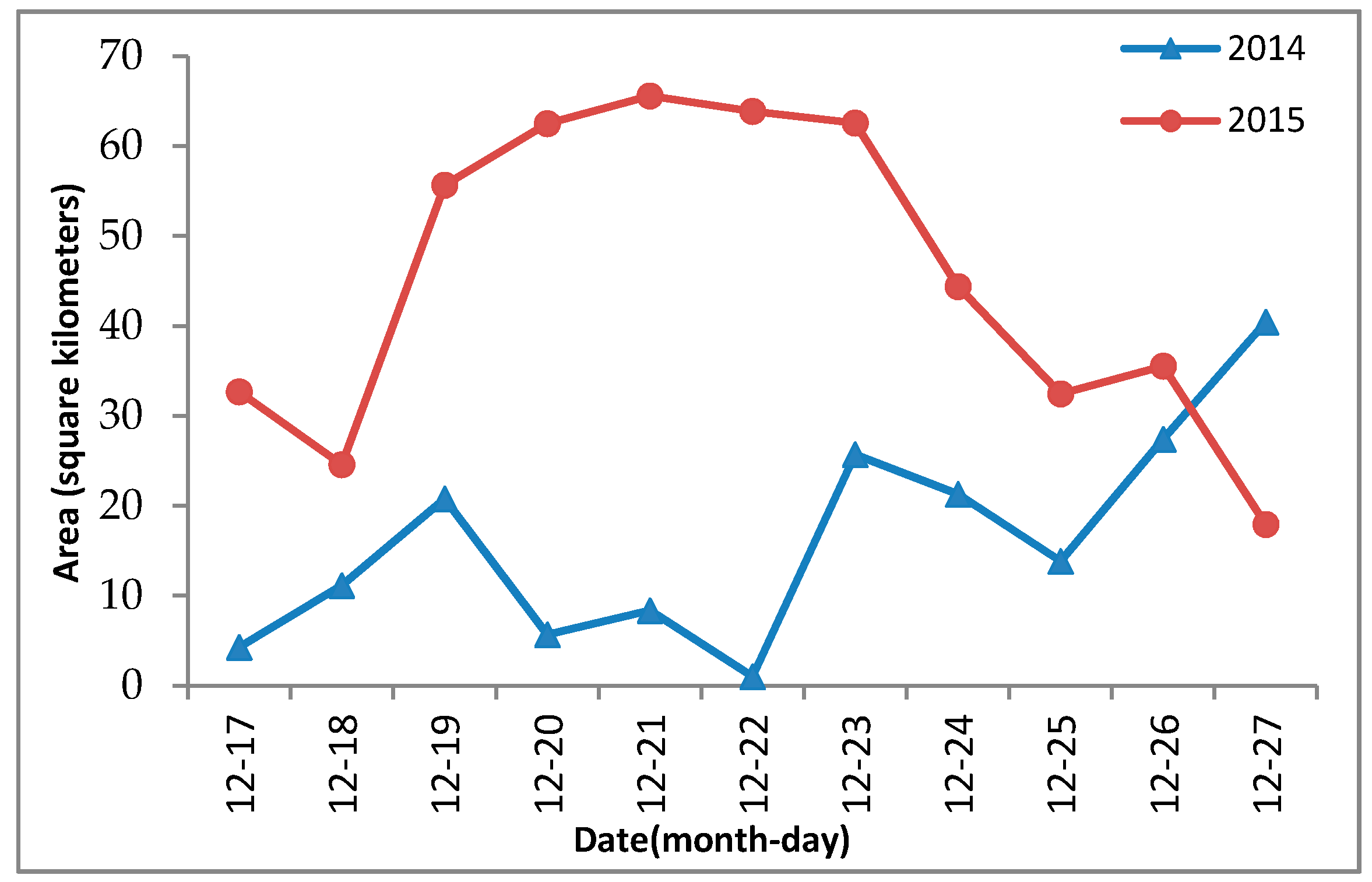
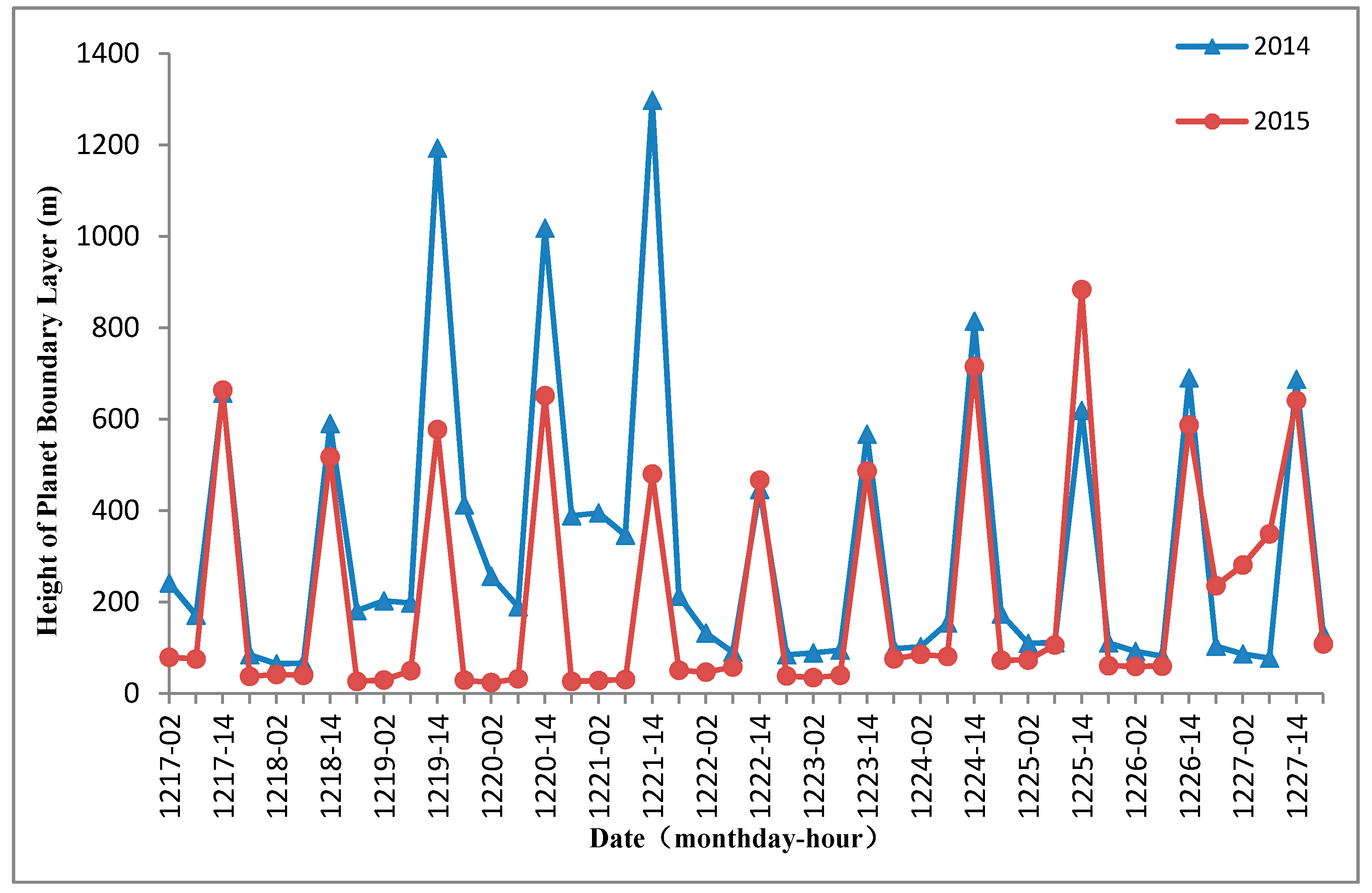
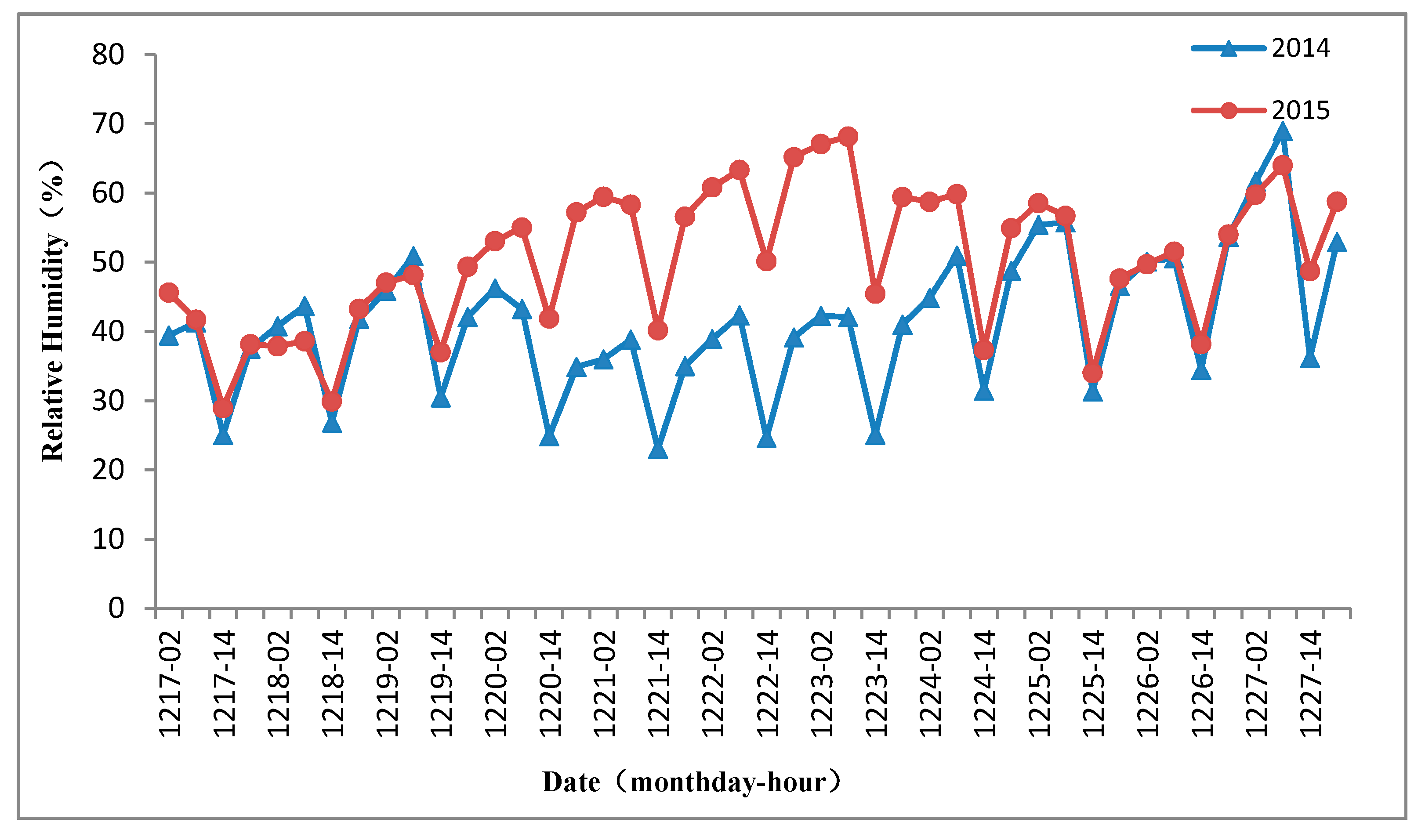
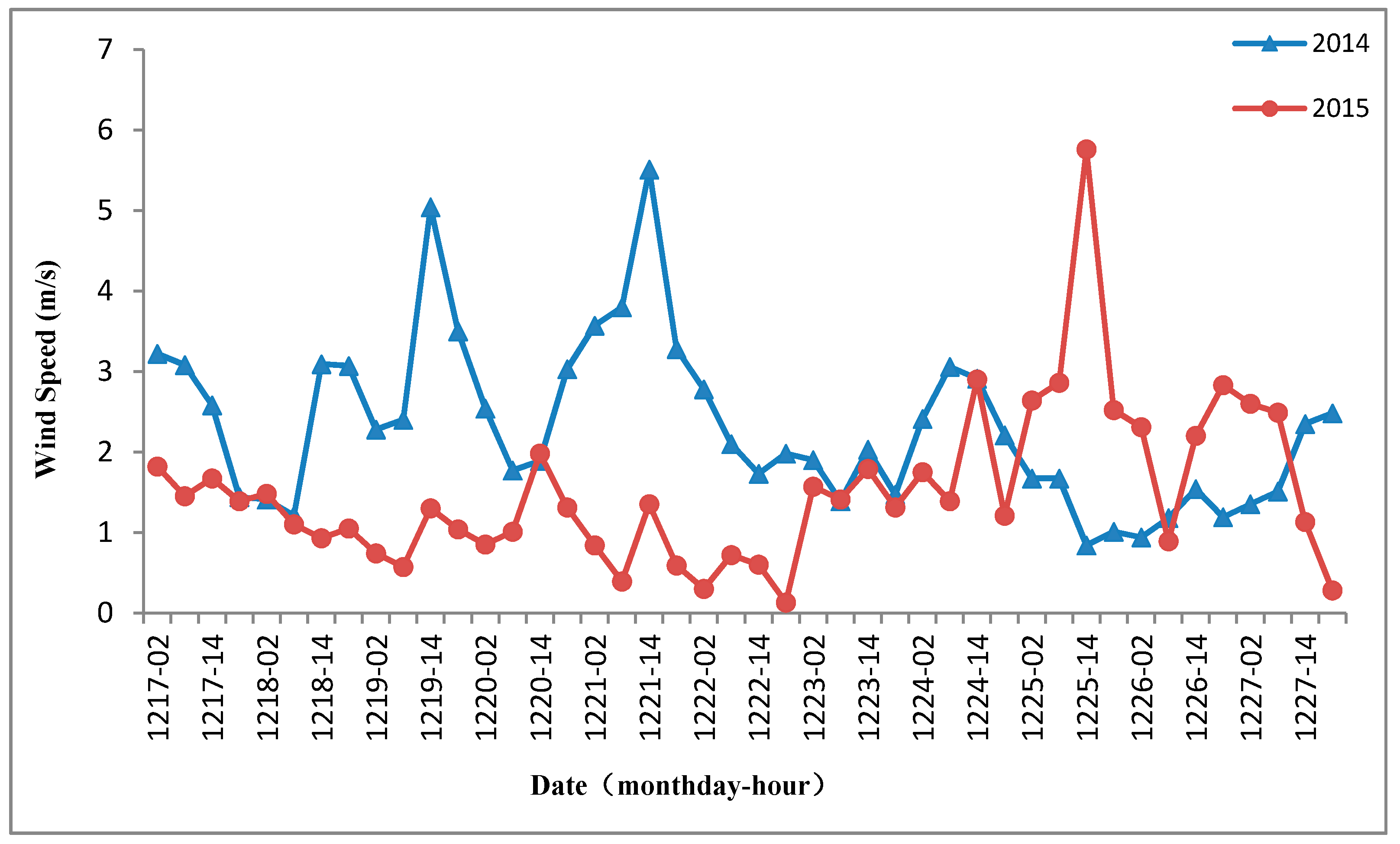
© 2017 by the authors. Licensee MDPI, Basel, Switzerland. This article is an open access article distributed under the terms and conditions of the Creative Commons Attribution (CC BY) license (http://creativecommons.org/licenses/by/4.0/).
Share and Cite
Wang, Q.; Li, Q.; Wang, Z.; Chen, H.; Mao, H.; Chen, C. A Quantitatively Operational Judging Method for the Process of Large Regional Heavy Haze Event Based on Satellite Remote Sensing and Numerical Simulations. Atmosphere 2017, 8, 222. https://doi.org/10.3390/atmos8110222
Wang Q, Li Q, Wang Z, Chen H, Mao H, Chen C. A Quantitatively Operational Judging Method for the Process of Large Regional Heavy Haze Event Based on Satellite Remote Sensing and Numerical Simulations. Atmosphere. 2017; 8(11):222. https://doi.org/10.3390/atmos8110222
Chicago/Turabian StyleWang, Qiao, Qing Li, Zhongting Wang, Hui Chen, Huiqin Mao, and Cuihong Chen. 2017. "A Quantitatively Operational Judging Method for the Process of Large Regional Heavy Haze Event Based on Satellite Remote Sensing and Numerical Simulations" Atmosphere 8, no. 11: 222. https://doi.org/10.3390/atmos8110222
APA StyleWang, Q., Li, Q., Wang, Z., Chen, H., Mao, H., & Chen, C. (2017). A Quantitatively Operational Judging Method for the Process of Large Regional Heavy Haze Event Based on Satellite Remote Sensing and Numerical Simulations. Atmosphere, 8(11), 222. https://doi.org/10.3390/atmos8110222



